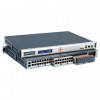Lantronix SLC 8000 Advanced Console Manager User Guide - Page 152
Troubleshooting Browser Issues, Add IP Address, Delete IP, Address, Apply, Secure Lantronix, Network
 |
View all Lantronix SLC 8000 Advanced Console Manager manuals
Add to My Manuals
Save this manual to your list of manuals |
Page 152 highlights
7: Services IP Address If you selected Manually Entered IP Address List or Both, enter the IP address of the secure Lantronix device you want to find and manage. 3. If you entered an IP address, click the Add IP Address button. The IP address displays in the IP Address List. 4. Repeat steps 2 and 3 for each IP address you want to add. 5. To delete an IP address from the IP Address List, select the address and click the Delete IP Address button. 6. Click the Apply button. When the confirmation message displays, click Secure Lantronix Network on the main menu. The Services > Secure Lantronix Network page displays the secure Lantronix devices resulting from the search. You can now manage these devices. Troubleshooting Browser Issues Depending on which browser you are using and what type of SSL certificate the SLC web server is configured with, there may be errors connecting to a Web SSH or Web Telnet session. These errors may be the standard browser error displayed for self-signed or untrusted certificates ("There is a problem with this website's security certificate." or "Your connection is not private."). The SSL server that handles Web SSH and Web Telnet sessions is accessible on port 8000, instead of the standard port 443 for SSL connections. It is recommended that the SLC be configured to use a SSL certificate from a Certificate Authority to prevent issues accessing Web SSH and Web Telnet terminals. If your SLC web server is configured to use a self-signed or untrusted SSL certificate, refer to the notes below for how to work around this for various browsers. When an SLC is configured with a SSL certificate that is either a wildcard certificate or associated with a specific name, in order to establish a Web SSH or Web Telnet session to the SLC unit, the unit must be able to successfully perform a reverse lookup on any IP address to which Web SSH or Web Telnet requests are sent. For example, if a unit is configured with a SSL certificate for the name "SLCXYZ.lantronix.com", and the unit website is being accessed in a browser with "https:// SLCXYZ.lantronix.com", the unit needs to be configured with a name server that will allow the unit to perform a reverse lookup on the IP address associated with SLCXYZ.lantronix.com. Failure to perform a reverse lookup on a name may result in name mismatch errors in the browser when it attempts to open the Web SSH or Web Telnet window. If you are unable to connect to a Web SSH or Web Telnet session for a reason other than a browser SSL certificate issue, restarting the SSL server on port 8000 may resolve the connection problem. This can be done by restarting the web server (with the CLI command "admin web restart") or by disabling both Web SSH and Web Telnet on the SSH/Telnet/Logging web page, and then re-enabling them. Chrome - For the greatest ease of use with Web SSH and Web Telnet, when the SLC web server is using a self-signed SSL certificate, use the Chrome browser. When the user accepts the self-signed SSL certificate in the browser for the primary SLC website, the self-signed SSL certificate is accepted for all ports - including port 8000 - for the SLC website. Firefox - When accessing the SLC website with Firefox, and when the SLC web server is using a self-signed SSL certificate, accepting the self-signed SSL certificate in the browser for the primary SLC website will only accept the certificate for port 443. It will not accept the certificate for port 8000. This may result in a popup being displayed in the Web SSH or Web Telnet window indicating that the browser needs to accept a certificate. To accept the selfsigned certificate for port 8000, go to Firefox -> Options (or Preferences) -> Advanced -> SLC™ 8000 Advanced Console Manager User Guide 152















